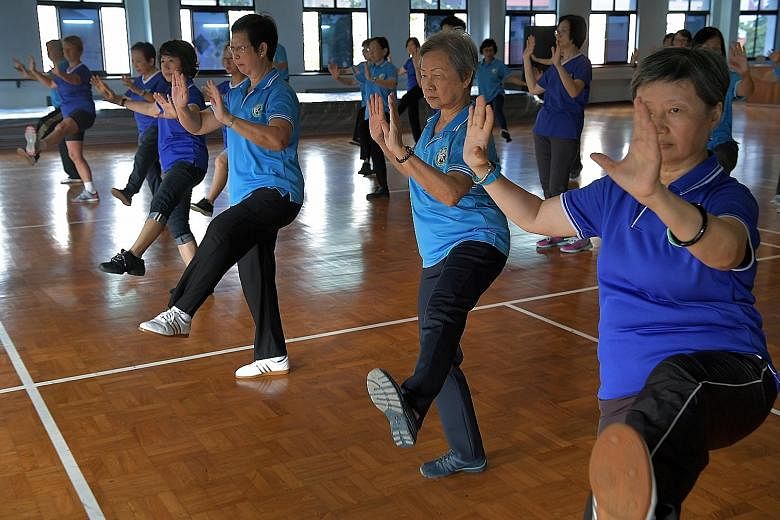Three times a week, Ms Elizabeth Toh spends an hour going through the slow, elegant motions of taiji.
The traditional Chinese exercise has improved her balance and helped her relax, said the retiree, who is in her 60s.
It has also helped with her chronic headaches, she said. "I used to take painkillers for headaches that were triggered by small things."
She recounted that one morning just before a taiji performance, she woke up with a headache. But by evening, after rehearsing her taiji steps many times, it was gone.
"That convinced me that I must keep at it," said Ms Toh, who has been practising taiji for eight years.
Taiji has its roots in Taoism and is widely practised in Singapore as a means of keeping in good health.
Classes range from beginners' courses at community centres to in-depth lessons taught by taiji masters. Sessions are modified for the less mobile.
Looking through the lens of Western medicine, how exactly does taiji help to strengthen mind and body?
This is what the Health Ministry is hoping to find out. It announced this month that it is expanding the scope of a $5-million research grant to include the study of traditional Chinese exercises such as taiji.
"I encourage our doctors and scientists to keep an open mind to the potential value which traditional Chinese medicine (TCM) can offer," said Senior Minister of State for Health Chee Hong Tat at the convocation of the Nanyang Technological University/Beijing University of Chinese Medicine biomedical sciences and TCM double-degree programme earlier this month.
Referring to China's former statesman, he said: "To paraphrase Mr Deng Xiaoping, it does not matter if the medicine's origins are Western or TCM - medicine which can cure diseases and keep the patient healthy is good medicine."
PHYSICAL AND MENTAL PERKS
One of the known benefits of taiji is better coordination and balance, said Dr Benedict Tan, chairman of Exercise is Medicine Singapore. This is a global health movement to make exercise part of healthcare.
"Taiji includes slow, controlled and coordinated movements that involve multiple joints and muscles," said Dr Tan, a sports medi- cine specialist. "Regular taiji exercises can improve coordination and balance and, to a lesser extent, strength and flexibility."
In other words, taiji is ideal for those over 65, who are encouraged to take part in activities that improve flexibility, balance and agility.
This is because falls at that age can have serious consequences, such as hip fractures which leave a person unable to walk.
Assistant Professor Swarup Mukherjee from the National Institute of Education said that taiji movements involve exercising the lower part of the back. These include bowing the waist and contracting the muscles around the hip, with weight being shifted around different parts of the body.
Prof Mukherjee, who specialises in physical education and sports science, is working with Nanyang Technological University (NTU) don Goh Chye Tee on a research project to study taiji as well as baduanjin, a form of qigong.
They will be looking at how these exercises affect the functioning of a person's nerves and muscles, as well as benefits to overall health.
"This research intends to combine traditional exercise forms and philosophies with modern scientific technologies, to assess musculoskeletal functions," said Dr Goh, director of biomedical sciences and Chinese medicine at NTU's School of Biological Sciences.
Ms Jennifer Chung, who has been running private taiji classes for more than 10 years, has started a seated taiji class. Those who attend have problems such as stroke or are too frail to stand for long periods.
"I started this class two years ago and more and more people have been showing interest," Ms Chung said. "Some of the moves are modified to make it easier for them."
One of those attending the seated classes is Madam Soh Wei Joo, 62. She had a stroke two years ago and attended her first taiji session in a wheelchair.
With regular taiji and physiotherapy sessions, she is now able to go to class on her own two feet.
She said: "They teach breathing techniques which help me to focus. It clears my mind."
In fact, mindfulness is a big component of taiji, said Mr William Seow, president of the Chen Shi Tai- jiquan Association (Singapore).
Mindfulness refers to learning to "be present" and focusing one's senses on the moment, rather than being distracted by the buzz of one's thoughts.
Similarly, a big part of taiji is learning techniques to consciously control one's breathing and focusing on the movements of the body.
"They call it moving meditation," said Mr Seow. "By relaxing the mental state, you focus on your body movements and forget the other things."
This eventually becomes a habit and can spill over into everyday life, helping people to maintain better posture and a calmer state of mind.
"I was a very impatient driver in my younger days," Mr Seow said. "Now, I don't get impatient anymore. It just comes naturally with practice."


